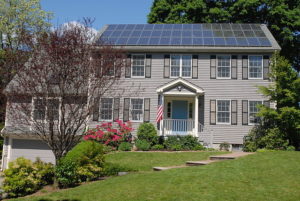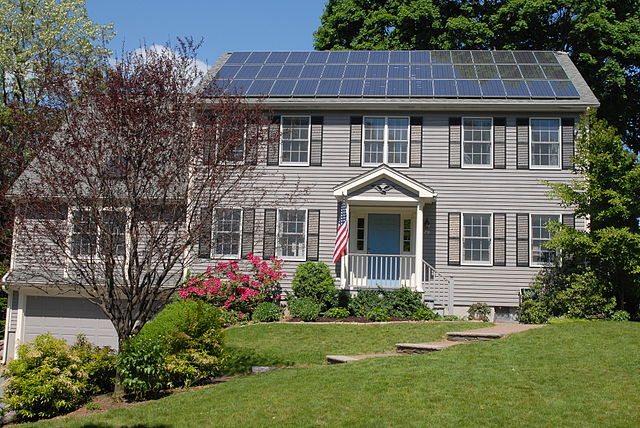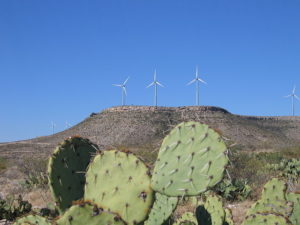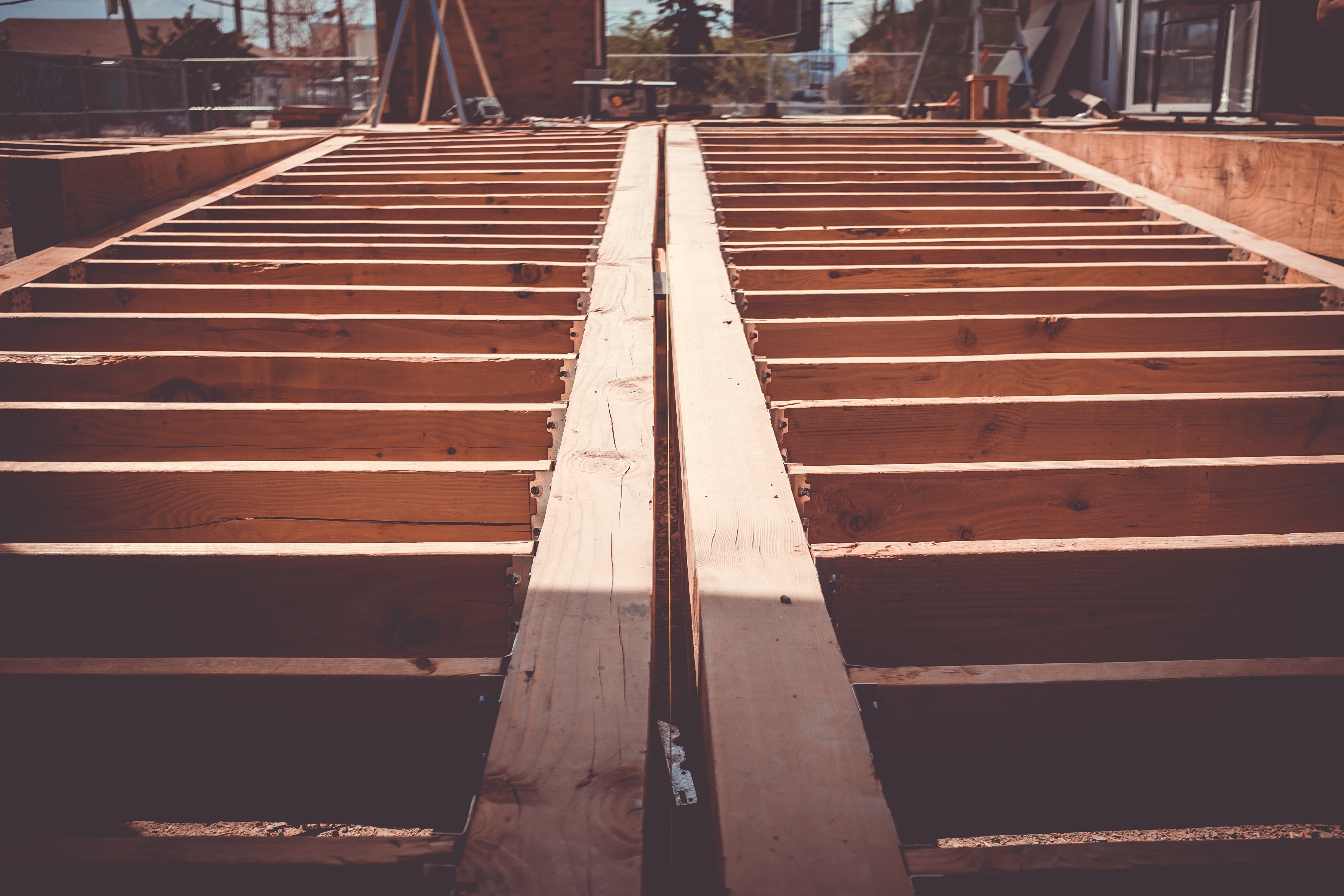
Solar panels on house roof by Gray Watson, CC BY-SA 3.0 via Wikimedia Commons.
In the last decade, the possibility of living in a home that runs on 100% renewable energy has become a reality. The price of solar panels for residential use continues to drop, those in rural areas might be able to use a microhydropower system or small wind turbine, and new building materials allow contractors and homebuyers to plan for homes that leave a much smaller footprint on the environment.
Where once it was hard to envision even a single person living with modern conveniences powered entirely by renewable resources, today cities and towns across the country are paving the way for larger communities to become reliable on electricity from only renewable energy sources. Georgetown, Texas, about 25 miles north of Austin in the central part of the oil- and gas-friendly state, is the latest city to make the leap. The city of nearly 60,000 people expects to receive all of its electricity from solar and wind power in the next few years.
The city council and mayor looked into renewable energy as a way to keep Georgetown growing and on the leading edge of economic development. The decision to move the mostly conservative city toward renewable energy was not about protecting the environment. In fact, city officials found the idea even more intriguing when they ran the numbers on how much money could be saved in the long run. Wind power prices were particularly low in early 2014 when the City signed a 144-megawatt (MW), 20-year deal with EDF Renewables [we’ve already written about how power purchase agreements (PPAs) benefit consumers].
“This was a business decision and it was a no-brainer,” said Georgetown Mayor Dale Ross. “This is a long-term source of power that creates cost certainty, brings economic development, uses less water, and helps the environment.”
Texas is a prime spot for wind energy, as anyone who has ever lived on the west side of the state can attest. Wind turbines in the state number in the thousands, and 10% of the state’s energy comes from wind. The state gets plenty of sun as well, although Texas lags behind many other states in solar power installations. Austin Energy, which serves the Texas capital as well as the surrounding areas, has a strong focus on renewable energy. About 23% of the energy produced by Austin Energy is from renewable sources, including wind, solar, and biomass.
Georgetown plans to source 100% of its electricity from renewable energy sources by 2017. The split will be almost 50/50 between solar and wind sources, which works well since wind is most productive at night. El Paso will send 150 MW of solar energy, and Amarillo will send about 144 MW of energy from its wind farms to Georgetown. The energy will be transported across the state thanks to Texas’s estimated $7 billion investment in transmission lines, an infrastructure project known as the Competitive Renewable Energy Zone (CREZ) program. The new lines will allow the west side of the state, rich in wind and solar power, to send that energy to the rest of Texas.
Georgetown is following in the footsteps of Burlington, Vermont, which earlier this year became the first city to run solely on electricity from renewable energy sources. Burlington is using wind and solar power, but also biomass and hydroelectricity, to wean the city of 42,000 off non-renewable power. Half of the power comes from hydroelectric dams, and another 30% is from biomass, burning wood chips from the local logging industry. The wood chips do not burn cleanly, but the particulate emissions are just 10% of the level permitted by state regulations. Solar and wind power supply another 20% of the electricity used by Burlington.
Like Georgetown’s city officials, the decision makers in Burlington also moved toward renewable resources for financial reasons, estimating that the city would likely save $20 million over the next decade.
“Greenhouse gas reduction is a major thing that we’re concerned about and we are always trying to improve on,” said Ken Nolan of the Burlington Electric Department. “But in looking at whether to buy renewable power, we really were focused on an economic decision at the time. Our financial analysis at that time indicated to our—actually, to our surprise—that the cheapest long-term financial investment for us with the least amount of risk was to move in this direction.”
While not every city is on the way to complete reliance on renewable energy, many communities have implemented voluntary programs to increase renewable energy use, such as the one in Naperville, Illinois. Naperville’s Renewable Energy Program allows residents and businesses to donate anywhere from $5 to $25 a month to add renewable energy to the Illinois power grid. The U.S. Department of Energy ranked Naperville 9th in the country in 2014 for customer participation rate in green power programs. With about 3,800 residents participating, the city helps develop more than 14,000 MWh of electricity each year through its Renewable Energy Program.
The push for renewable energy is growing. A January article on Mother Nature Network listed 10 cities around the world seeking to be powered solely by renewable resources, some of them by as early as the end of this year.
Renewable energy is no longer seen as just a cause urged on by progressives and environmentalists. Cities across the country are doing the math, and going green is saving them money.
How many cities do you think will get 100% of their electricity from renewable energy sources in the next five years? Ten years? Let us know in the comments.







Recent Comments